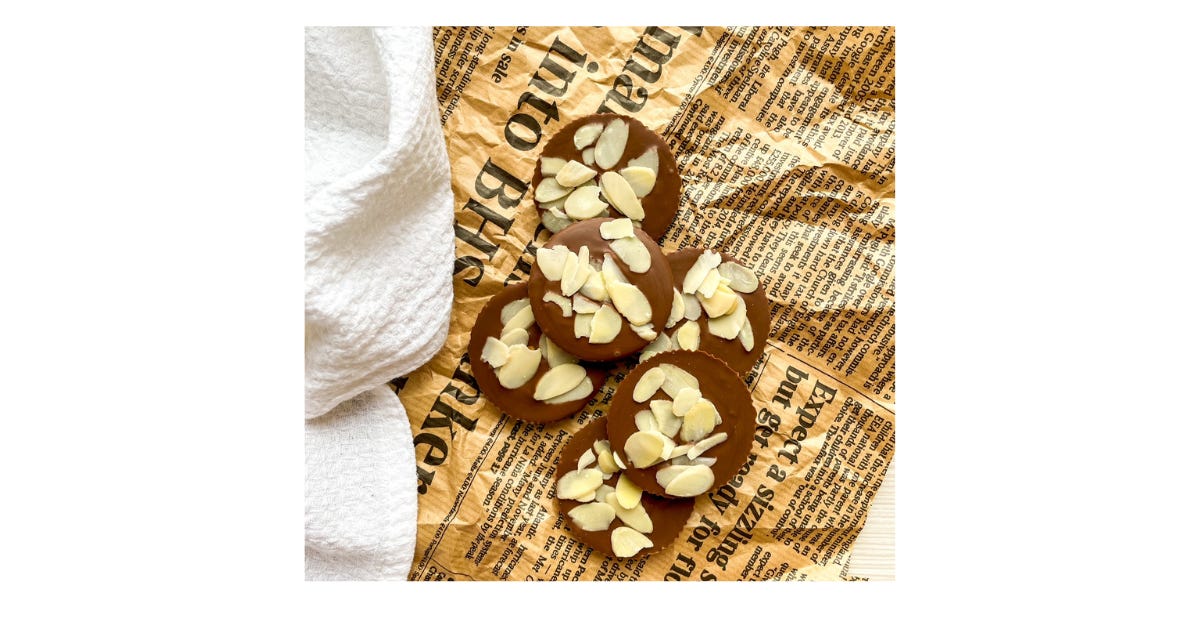When I was growing up in the 1980s, Hanukkah gelt was an ultra-processed, waxy, overly sweet milk chocolate experience. Looking back, I wonder if it was even real chocolate at all! The best part wasn’t the candy itself but peeling off the shiny gold foil, savoring the anticipation more than the treat. These days, there are far better chocolate gelt options available, but this year, with my focus on low-carb living and avoiding sugar spikes, I decided to try making a low-carb version at home.
This recipe honors the sweet tradition of Hanukkah gelt while keeping it health-conscious. By using sugar replacements and rich unsweetened chocolate, we’ve crafted a modern version with a deep, rich flavor. The addition of flaked almonds gives it a beautiful golden touch and satisfying crunch.
Giving Hanukkah gelt is a custom deeply tied to the Festival of Lights. It likely began with the tradition of giving small coins as gifts and evolved into chocolate treats enjoyed by children and adults alike. But the Jewish connection to chocolate extends far beyond the gelt we know today.
In On the Chocolate Trail: A Delicious Adventure Connecting Jews, Religions, History, Travel, Rituals, and Recipes to the Magic of Cacao, Rabbi Deborah Prinz delves into this unique bond between Jews and chocolate. The book traces the journey of cacao across centuries, uncovering the pivotal role of Jewish merchants in the global chocolate trade, the ways chocolate has been incorporated into Jewish rituals, and the cultural exchanges that shaped its history. From the expulsion of Jews during the Spanish Inquisition to their influence on chocolate-making in the New World, Rabbi Prinz tells a compelling story of resilience and adaptability through the lens of chocolate. Along the way, she weaves in travel anecdotes, religious insights, and mouthwatering recipes, making this book a must-read for history buffs, chocolate lovers, and anyone curious about the sweet connections between food and faith.
Sweeteners in Low-Carb Recipes
Sugar replacements can help reduce carb intake while still satisfying your sweet tooth and enjoying your favorite recipes. There are three main alternative sweeteners I recommend:
Stevia: A natural sweetener derived from the stevia plant, it’s hundreds of times sweeter than sugar, meaning you only need a tiny amount. Some people find it has a slight aftertaste, but it blends well with chocolate, especially dark varieties which have a strong taste.
Erythritol: A sugar alcohol that occurs naturally in some fruits, it provides sweetness with minimal impact on blood sugar. It’s well-tolerated by most, though some people experience mild digestive discomfort if consumed in large amounts.
Allulose: A rare sugar found in small quantities in foods like figs and raisins, Allulose is almost calorie-free and has a clean sweetness similar to table sugar. It doesn’t raise blood sugar or insulin levels, making it a popular choice for keto-friendly recipes.
There are conflicting health claims about all of these sweeteners, but they are a helpful alternative when used occasionally in small amounts. The key is moderation, as part of a balanced approach to enjoying treats while keeping your overall health goals in mind.
Why I Love Chocolate
I adore chocolate and enjoy it every single day! My go-to is 100% dark chocolate or low-sugar varieties (this is Israeli zero sugar chocolate is my favorite) that align with my health goals without compromising on flavor. The higher the percentage, the higher the actual cocoa content, rather than being packed out with fillers and sugar. Beyond its rich, satisfying taste, chocolate—especially dark chocolate—offers several health benefits:
Rich in Antioxidants: Dark chocolate is packed with flavonoids, which are powerful antioxidants that can help protect cells from damage caused by free radicals.
Heart Health: Studies suggest that the flavonoids in dark chocolate may improve blood flow, lower blood pressure, and support heart health when enjoyed in moderation.
Mood Boosting: Chocolate contains compounds like theobromine and phenylethylamine, which can enhance mood and promote feelings of happiness.
Brain Support: Some research indicates that the antioxidants and natural stimulants in dark chocolate can improve cognitive function and reduce the risk of neurodegenerative conditions.
Perhaps the most important point of all is that chocolate is an enjoyable treat, so any healthy eating approach needs to find ways to include it in moderation.
This recipe celebrates chocolate as both a delicious treat and a nutrient-rich ingredient, letting you indulge while reaping its benefits.
Low Carb Chocolate Gelt Recipe
Category: (Pareve)
Prep time: 10 minutes
Cook time: 5 minutes
Total time: 15 minutes
Yield: 10-12
Ingredients:
6 oz. unsweetened chocolate, broken into smaller pieces
1 tablespoon coconut oil
1 teaspoon vanilla extract
½ teaspoon stevia or 2-3 tablespoons Erythritol or Allulose
¼ teaspoon salt
3 tablespoons flaked almonds
Tools:
Medium pot
Measuring cups and spoons
Muffin tin
Paper liners
Instructions:
Add the chocolate, coconut oil, vanilla, stevia, and salt to a medium pot and place over very low heat. Allow to melt gently, while stirring occasionally to prevent burning.
In the meantime, line a muffin tin with paper liners.
Once fully melted, add a tablespoon of the chocolate mixture into each muffin hole.
Top with flaked almonds and place in the fridge to set for at least 30 minutes.
I am never giving up chocolate, and if you’re a fellow chocolate lover, I hope you don’t either! With a little creativity and care, we can transform beloved traditions into delicious, healthier treats that nourish both body and soul. What’s your go-to chocolate treat? Share your favorites with us in the comments and inspire our next chocolate adventure!
Am Yisrael Chai
Kenden











Great idea to make gelt at home!...watch out. for sugar alcohols like erythritol which emerging data shows negative cardiovascular effects-
LOVE everything about this! Happy 🕎 Chanukah. ~Joan